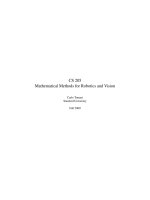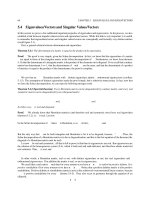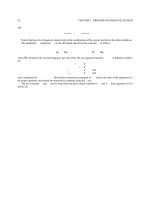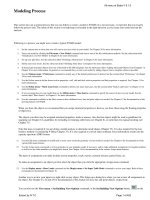Ebook A Handbook of spectroscopic data chemistry Part 1
Bạn đang xem bản rút gọn của tài liệu. Xem và tải ngay bản đầy đủ của tài liệu tại đây (2.84 MB, 103 trang )
A Handbook of
Spectroscopic Data
CHEMISTRY
(UV, JR, PMR, JJCNMR and Mass Spectroscopy)
B.D. Mistry
B.K.M. Science College.
Va/sad - (Gujarat)
Oxford Book Company
Jaipur, India
ISBN: 978-81-89473-86-0
Edition 2009
Oxford Book Company
267, 10-B-Scheme. Opp. Narayan Niwas,
Gopalpura By Pass Road, Jaipur-302018
Phone: 0141-2594705, Fax: 0141-2597527
e-mail:
website: www.oxfordbookcompany.com
© Reserved
Typeset by:
Shivangi Computers
267, lO-B-Scheme, Opp. Narayan Niwas.
Gopalpura By Pass Road, Jaipur-302018
Printed at :
. Mehra Offset Printers, Delhi.
All Rights are Reserved. No part of this publication may be reproduced. stored in a
retrieval system, or transmitted, in any form or by any means, electronic,
mechanical, photocopying. recording, scanning or otherwise, without the prior
\HItten permission of the copyright owner. Responsibility for the facts stated.
opinions expressed, conclusions reached and plagiarism, if any, in this volume is
entirely that of the Author, according to whom the matter encompassed in this
book has been originally created/edited and resemblance with any such
publication may be incidental. The Publisher bears no responsibility for them,
whatsoever.
Contents
1.
Ultraviolet Spectroscopy
2. Infrared Spectroscopy
3. Proton Magnetic Resonance Spectroscopy
4. Be NMR Spectroscopy
5.
Mass Spectrometry
6.
Structural Data Obtainable from Different Spectra
Index
1
26
64
99
128
237
240
"This page is Intentionally Left Blank"
1
Ultraviolet Spectroscopy
1.1
Calculating Absorption Maxima of Unsaturated Compounds
Dienes and trienes : If the compound is suspected to be a conjugated
or substituted diene, its wavelength of maximum absorption can be predicted
with the help of Table I. I. To be able to use this table, one must first learn to
recognize different types of dienes, conjugations, double bonds, etc. These
are as follows:
c=c< _ ) C=C< A linear conjugation; for example, 1,3,5
C-C
hexatriene, isoprene,etc.
) C=C<
A cross conjugation.
ii) )C=C
)C=C<
i) )
iii)
iv)
o
o
A cyclic diene; for example, cyclohexadiene,
cyclohepta 1,3- diene, etc.
A semicyclic diene; one of the double bonds
forms part of a ring and the other is
exocyclic, or outside the ring. When only
one of of the two Sp2 hybridized carbons of
a double bond is a part of the ring under
2
Spectroscopic Data Chemistry
consideration, such a double bond is called
an exocycIic double bond.
A homoannular diene is one in which the
v)
two double bonds are conjugated and are in
a single ring.
Note that both double bonds are
exocycIic to ring B.
vi)
A heteroannular diene is a conjugated system
in which the two double bonds belong to two
different rings. However, these double bonds
are also exocycIic, one of them being exoto ring A and the other exo-to ring B.
Table 1.1: Woodward's and Fieser's rules for Diene absorption (ethanol
solution)
i)
Base value for an unsubstituted, conjugated, acyclic or
heteroannular diene
ii)
214 nm
Base value for an unsubstituted, conjugated
homoannular diene
253 nm
Increments for
iii) Extra double bonds in conjugation (for each C=C)
+30 nm
iv) ExocycIic double bond (effect is two fold ifbond is
exocylic to two rings)
v)
+5nm
Substitutents on Sp2 hybridised carbon atom, per substituent
a) O-acyl (-O-CO-R or -O-CO-Ar)
Onm
b) Simple alkyl (-R) or ring residue
+5nm
c) Halogen (-CI, -Br)
+5nm
d) O-alkyl (-OR)
+6nm
e) S-alkyl (-SR)
+30nm
f) N-alkyl, (-NRR ')
+ 60 nm
vi) Solvent correction
Onm
3
Ultraviolet Spectroscopy
,
The following points are to be noted:
•
The cyclic homoannular base values refer to a six membered ring
only. For other rings the values are:
Five membered ring (C s)
228 nm
Seven membered ring (C 7 )
241 nm
•
Accuracy of prediction is ± 5 nm
•
If there is more than one possibility for calculating Amax, the highest
Amax value usually agrees with the observed value.
Limitations
•
Agreement is quite good for acyclic and six-membered ring polyenes
but not so for other rings in some cases.
•
Steric strain can also affect the position (Amax) of the band,
sometimes very greatly if the strain is high. A simple example of
this is 1,2 dimethylene cyclohexane, which gives a strong UV band
at Amax 220 nm (E 10,050) which is quite different from the
calcualted value.
Polyenes : The above rules (Table 1.1) holds fairly well for unsaturated
compounds containing up to four conjugated double bonds. However, for
systems of extended conjugation, such as those found in carotenoid pigments,
Fieser and Kuhn have suggested equations to calculate the basic Amax and
Em.. ofUV absorption.
Amax (in hexane) = 114 + 5M + n (48.0 - 1.7n) -I 6. 5Rendo - IOR exo
E ma , (in hexane)
=
1.74 x 104n
Where
n = number of conjugated double bonds
M = number of alkyl or alkyl like substituents on the conjugated system.
Rendo = number of rings with endocyclic double bonds in the conjugated system.
Rexo =
1.2
number of rings with exocyclic double bonds.
Calculating Absorption Maxima of Carbonyl Compounds
The basic chromophore containing a >C=C< (--ene) conjugated with a
>c=o (-one), as in
4
Spectroscopic Data Chemistry
P
a
> C = C- C = 0
.
IS
called an enone. If a carbonyl group is conjugated
with two double bonds (-cliene), such as
Ii
y
P a
>C=C-C = C-C = 0
The compound is known as a dienone. In the case of cyclic compounds,
the ethylenic double bonds conjugated with the carbonyl may be homoannular
or heteroannular.
Table 1.2: Rules of Enone and Dienone absorption
P-
paZ
0
y
paZ
I
I
I
I
I
I
I
I
C = C - C = 0 and 0 - C = C - C = C - C = 0
Enone
Dienone
Z = C, enone, Z = H, aldehyde
Z = OH, acid, Z = OR, ester
Parent enone (acyclic or rings larger than 5 members)
5-membered cyclic enone
Aldehydes
Acid and Esters
Increments for Double bond extending conjugation (for eacb one)
Homodiene component
Exocyclic double bond (or any >C=C< endocyclic to 5- or 7member ring in a case of acid and ester)
Alkyl group, ring residue
a
p
215nm
205nm
210nm
195nm
+30nm
+39nm
+5nm
+IOnm
+12nm
y
Hydroxyl (-OH)
Alkoxyl (-OCH 3)
and higher
+ISnm
a
+35nm
p
+30nm
y
a
y
50nm
+35nm
+30nm
+ 17nm
o
31nm
p
5
Ultraviolet Spectroscopy
Acetoxyl (-O-COCH 3 )
Dialkyl aniino (-NR)
Chlorine (-CI)
a, ~ or <')
f
~
a
+ 15nm
+12nm
+ 85nm
+ 25nm
Thioalkyl (-SR)
Bromine (-Br)
6nm
+ 95nm
a
~
Solvent correction (see table below)
+30nm
variable
Solvent Corrections (Enones)
Solvent
Ethanol
Methanol
Water
Chloroform
Dioxane
Ether
Hexane
Cyclohexane
Correction
o
o
-8 nm
+ I nm
+5 nm
+7nm
+ 11 nm
+ II run
Accuracy of prediction ± 5 nm.
1.3
Calculating Absorption Maxima of Aromatic Molecules
There are two types of aromatic molecules: benzenoid and
nonbenzenoid. Their spectra show considerable resemblance. In fact, the
presence or absence of certain features in UV spectra, such as a low intensity
band (known as a fine structure band) at or about 255 run, is often used to
detect the aromatic character of an unknown substance.
Benzene Chromophore
The simplest aromatic compound is benzene. It has a ring current of 1t
electrons, which shows strong 1t ~ 1t* absorptions at 184 run (Em" 60,000),
and at 204 nm (Emax 7900). (This is called a primary band.) Benzene exhibits
a low intensity band at 256 nm (Emax 200) (Known as a secondary or finestructure band), with a series offine-structue bands between 230 and 270 nm).
Any substitution ~ the benzene ring, irrespective of its electronic character
6
Spectroscopic Data Chemistry
(electron-donating or electron-withdrawing character) shift the primary band
(204 nm) to longer wave lengths. With polar substituents, e.g.
etc. which allow for the n
~ 1t
-N~,
-OH,
conjugation and -C = 0 and -N0 2 where
polarisability is of importance, absorption due to electron transfer transitions
is apparent. These two types of transfer can be expressed as shown below:
Chromophore substitutents:
Auxochrome substituents:
Table 1.3: Scotts rules for calculation ofAmax ofthe ET (electron transfer)
band of aromatic carbonyl compounds
Ar-C-Z
II
o
Parent chromophore : Ar=C6HS
Z = Alkyl or ring residue, (e.g.; ArCOR) 246 run
250 run
Z = H, (Ar CHO)
Z = OH, OAlk, (ArCOOH and ArCOOR) 230 run
Increment for each substitutent on Ar:
- Alkyl or ring residue
0-, m+3 nm
p+ 10 nm
- OH, -OAlk
+7 run
0-, m+25 run
p-- 0- (oxyanion) •
+Ilnm
o+20 run
m+ 78 run"
p-
In heterocyclic chemistry
model compounds are
essential for the interpretation of most spectra.
No rules are available for
the predicition ofthe wavelength maxima ofaromatic
compounds except in the
case of aromatic carbonyl
compounds where acetophenone is taken as the
parent chromophore, and
increments allotted on the
usual basis (Table 1.3)
7
Ultraviolet Spectroscopy
--
CI
0--,
m-
+0 mn
p-
+ 10 nm
-
Br
0--,
m-
-
-
NH2
NHCOCH 3
t
2 nm
p-
+ 15 nm
o-,m-
+I3nm
p-
+ 58 nm
o-,m-
+20nm
+45nm
-
NHCH 3
pp-
-
N(CH 3)2
o-,m-
+20nm
p-
+ 85 nm
+ 73 nm
"This value may be decreased markedly by steric hindrance to coplanarity.
Let us now apply the rules in Table 1.1, 1.2, and 1.3 to a few known
compounds and compare the resulting values of Amax with the values observed
experimentally.
I. Dienes
(1) Abietic acid
Basic heteroannular diene
214nm
Exocyclic double bonds (1 x 5)
05nm
Substituents R (4
20nm
x
5)
Calculated Amax
239nm
Observed
241 nm
[Chromophore is shown by heavy lines; numbers indicate substituents.]
Spectroscopic Data Chemistry
8
(2) Ergosterol
HO
253 nm
Basic homoannular diene
Exocyclic double bonds (2 x 5)
lOnm
Substituents R (4 x 5)
20nm
Calculated "'-max
283 nm
Observed
282 nm
3.3, j3-Acetoxyergosta-5,7,14,22-tetraene
4
In compounds containing both
homoannular and heteroannular double
bonds, the diene system which requires
least energy for excitation (i.e. the one
with the longer wavelength of absorption)
is used as a base.
253 nm
15 nm
25nm
30nm
Basic homoannular diene
Exocyclic double bonds (3 x 5)
Substituents R (5 x 5)
Extra double bond in conjugation
323 nm
319nm
Calculated "'-max
Observed
II. Polyenes
(1) All trans j3-carotene
Me
Me
Me
Me
Me
Ultraviolet Spectroscopy
9
Basic Amax value
114 nm
M
= number of alkyl substituents, 5 x 10 add
50 nm
n = number of conjugated double bonds,
11
x
[48-(1.7
x
11)]
add
322.3 nm
Rendo = number of rings with endocyclic double bonds,
2 x 16.5, substract
Rexo
= number of rings with exocyclic double bonds,
ox
Emax
33.0 nm
10, substract
00.0 nm
Calculated Amax
453.30 nm
Observed
452.00 nm
=
1.74 x 11 x 104
= I 9.1 x 104 (calculated)
=
*
15.2 x 10 4 (observed*)
The equation for calculating
Emax
is semi-empirical, the value calculated
does not always correspond well with the observed value.
(2) All trans Iycopene
114 nm
Basic Amax
M=5 x 8
add
40nm
n= 11 x 148-(1.7 xII)
add
322.3 nm
(Note: Double bonds at ends are not in conjugation with others)
E
max
= 1.74
substract
00.0 nm
substract
00.0 nm
Calculated Amax
476.30 nm
Observed
474.00 nm
x II x 104
= 19.1 x 104 (calculated)
= 18.6
x 104 (observed)
10
Spectroscopic Data Chemistry
III. Enones
(1) Cholest--4-en-3-0ne
Parent base
Subst::iJ:uents~, ~
(2 x 12) add
Exocyclic = C< add
215 nm
24 nm
05nm
Calculated AEtOH
max
244nm
Observed
241 nm
(2) Cholesta-2,4-dien-()....{)ne
Parent base
Extended conjugation
Homoannular component
Substituents a. (l x 10)
8 (l x 18)
(3) 3,
215 nm
add
add
add
add
30nm
39nm
10 nm
18 nm
Calculated AEtOH
max
312 nm
Observed
314 nm
~-Acetoxy-7-()xolanosta-5,18,11-triene
11
Ultraviolet Spectroscopy
215 nm
Parent base
Extended conjugation
add
30 nm
Homoannular component
add
39 nm
Exocyclic double bond
add
5nm
Substituents a(l)( 10)
add
10nm
12)
add
12 nm
0(\ x 18)
add
18 nm
~ (\ x
Calculated A. EtOH
max
329 nm
Observed
327 nm
(4) Cycloheptene-l--carboxylic acid
a
0
II
ot~H
IK. p
Parent base
Substituents a(l x lO)
add
IOnm
~(lxI2)
add
12 om
add
05 nm
C=C endocyclic to 7-member ring,
Calculated A. EtOH
max
195 nm
222 nm
(5) 3-MethyI-2-butenoic acid
CH 3
H
I
I
CH 3-C = C-COOH
t
t
~
a
Parent base
195 nm
Substituents a (l x 10)
~(l x
10 nm
12)
12 nm
Calculated
217 nm
Observed value
216 nm
12
Spectroscopic Data Chemistry
Dicarbonyl compounds
Diosphenol
215 run
Parent base
2~
Substituents
(2 x 12)
24 run
a-OH (1 x 35)
Calculated
35 run
AEtOH
max
274 run
Observed AEtOH
max
270nm
In cyclic a-diketones, the enolic form is generally more stable than the
keto foml and therefore, the absorption is related to that of an a, 13-unsaturated
carbonyl system. Six-membered cyclic a-diketone known generally as
diosphenols, exist in solution largely in the enolised form. In strong alkaline
solution the absorption shifts to about 50 nm to longer waves, due to the
formation of the enolate ion, to enable diosphenol structures to be characterised.
Acetyl acetone exists in the enolic form to the extent of about 90% in
solution in non-polar solvents and the absorption directly depends on the
concentration of the enol tautomer.
..' H ""
o
0
0
II
II
II
CH -C
J
<
C·CH
'"
/
J
,
a~-diketone
Isoo ctane 272
,
274,
C.CH.
-'"
CH
Acetyl acetone
1
I
>CH.--C
CH 2
"'rna,,;
0
Ema~ 12,000
E
max
2050
-f"
'
Ultraviolet Spectroscopy
13
However, in the case of acetyl acetone agreement with the calculated
wavelength (257 nm) is indifferent. This may be due to the fact that the strong
internal hydrogen bond forces the carbonyl group and the double bond into a
configuration different from that which is present in cyclic structures, e.g.,
diosphenol exists almost entirely in the enolic form.
1,3-cyclohexanedione, absorbs at 253 nm
(Emax
22,000) in ethanol
O~OH
O~O
V<-->~ -V
1,3-Cyclohexanedione
The formation of enolate ion in alkaline solution in these cases also
shifts the strong absorption band. Quinones represent a-, or vinylogous adiketones. The spectrum of p-benzoquinone is thus found to be similar with
that of a typical a, f)-unsaturated ketone with the strong K-band appearing at
242 nrn and a weak R-band near 434 nm.
A.~:ne = 242 nrn (E 24,000)
6
(7t ~ 7t*
K-band)
281 nrn (E 400)} n ~ 7t *
434 run (E 20) R - band
o
The colour of the simpler members is due to the weak n ~ 7t* transition
which is also present in a-diketones. The n ~ 7t* transitions of a-diketones in
the diketo form gives rise to two bands one in the usual region near 290 nm
(E
~
30) and a second (E 10 ~ 30) which stretches into the visible 340--440 nm
region to give yellow colour to some of these compounds.
IV. Aromatic carbonyl compounds
o
II
1.
I -. . . :
HO"'-.cr
/
HO
~
C
Base value
"-. CH
246nm
OHinm
07 nm
OH inp
25 nm
3
278 nrn
14
Spectroscopic Data Chemistry
0
2.
Base value
00
(CH,),NO
H,NO
Brin m
-CH 2 in 0
246nm
02nm
03 nm
251 nm
Br
3.
~
4.
I~
Base value
250nm
NMe 2 inp
85nm
335 nm
CHO
Base value
230nm
NH2 in p
58nm
288nm
COOH
Another approach to predicting, the "-max of the primary band of
substituted benzenes involves the use ofTable 1.5. This table has been successfully
used with disubstituted compounds when the following rules are used:
I. Para substitution:
a.
b.
Both groups are either electron donating or electron withdrawing:
Only the effect of the group causing the larger shift is used. For
example, the "-max ofp-nitrobenzoic acid would be expected to be
the same as that of nitrobenzene, -(203.5 + 65.0) = -268.5 (in
alcohol solvent).
One group is electron donating and the other electron withdrawing:
The shift in the primary band of such a disubstituted benzene is
usually greater than the sum ofthe shifts caused individually by the
two groups. Such large shifts in p-disubstituted benzens are
attributed to interaction resonance, as illustrated below:
15
Ultraviolet Spectroscopy
2. Ortho and Meta substitution: The shift effects are additive.
Table 1.4: Absorption characteristics of some polycyclic aromatic
compounds
Compound
Amax,
emax
nm
Amax, emax
nm
Amax, emax
nm
CD
184
47,000
203
7,400
255
230
ro
220
1,10,000
275
5,600
314
316
OGCJ
252
2,00,000
375
7,900
252
50,000
295
13,000
330
250
240
89,000
334
50,000
352
6(30
268
1,41,000
320
13,000
360
630
278
1,30,000
473
11,000
580
12,600
Benzene
:::-..
/-
Napthalene
:::-..
//Anthracene
~
I"
/-
Phenanthrene
m
~ I/-
Pyrene
Chrysene
OXO
:::-..
/-/-/-
Napthacene
:::-..
~
/-/-/-/-
Pentacene
• These weak bands are usually submerged by strong adjacent bands .
16
Spectroscopic Data Chemistry
~
Table 1.5: Calculation of the Primary Band (1[
substituted Benzenes (CH 30H solvent)
Base Value: 203. 5 nm
1[*Transition) of
Substitutent
Shift
Substituent
Shift
-C H3
-CN
-CHO
-COCH3
-COOH
-Br
-CI
3.0
20.5
46.0
42.0
25.5
6.5
6.0
-NH2
-NHCOCK
-N02
26.5
38.5
65.0
7.0
31.5
13.5
J
-OH
-0-OCH 3
Absorption Characteristics of Disubstituted Benzens:
1[
Compound
o-N0 2 Phenol
m-N0 2 Phenol
p-N0 2 Phenol
o-N0 2 Aniline
m-N0 2 Aniline
p-NO? Aniline
~
1[*
Transition
KBand
Amax (nm)
Emax
279
6,600
274
6,000
318
10,000
283
5,400
280
4,800
381
13,500
BBand
Amax (nm)
Emax
3,200
351
333
1.960
Submerged
412
4,500
358
1,450
Submerged
Table 1.6: Absorption characteristics of Aromatic systems and their
substituted derivatives
Compound
Solvent
Primary band
1[ ~ 1[*
Transition
KBand
Amax
E
rna,
(nm)
Benzene
Toluene
o-Xylene
Hexane
204
Methanol(2%) 206.5
Methanol
210
1[
Secondary band
1[*
n ~ 1[*
~
Transition
BBand
Transition
RBand
Amax
Amax
E
max
(nm)
7,900
7,000
8,300
256
261
263
(nm)
200
225
300
E max
17
Ultraviolet Spectroscopy
Compound
Solvent
Primary band
1t ~ 1t*
Transition
KBand
Amax
Emax
(nm)
Secondary band
n ~ 1t*
Transition
Transition
RBand
BBand
1t .~ 1[*
A
A
Emax
max
max
Emax
(nm)
(nm)
m-Xylene
Methanol
212
7,200
265
300
p-Xylene
Methanol
212
8,000
274
460
244
15,000
280
1500
328
20
Acetophenone Ethanol
240
13,000
278
1,100
319
50
Benzophenone Ethanol
252
20,000
325
180
Nitrobenzene
Hexane
252
10,000
280
1,000
330
125
Benzonitrile
Water
224
13,000
271
1,000
Alcohol
232
14,000
262 2,400
sylfone
Alcohol
217
6,700
Biphenyl
Alcohol
246
20,000
Benzaidehyde Ethanol
Diphenyl
Sulfoxide
Methyl phenyl
2,2'-Dimethyl
264
977
Submerged
222
270
800
methane
Ethanol
Styrene
Hexane
Phenylacetylene
500
244
236
12,000
12,500
262
282
278
Stilbene (cis)
Alcohol
283
12,300
Submerged
Stilbene (trans) Alcohol
295
25,000
Submerged
Cinnamic acid (cis)
268
10,700
(trans)
272
15,900
biphenyl
Diphenyl-
-
1-Pheny I-I ,3butadiene (cis) Isooctane
268
18,500
(trans) Isooctane
1,3-Pentadiene
280
27,000
223
223.5
22,600
(cis) Alcohol
(trans) Alcohol
23,000
450
650
18
Spectroscopic Data Chemistry
Compound
Solvent
Primary band
n
~
n*
Transition
KBand
Amax
E
max
(nm)
Secondary band
n*
n ~ n*
Transition
Transition
BBand
RBand
Amax E m.. Amax E rna<
(nm)
(nm)
n
~
Chlorobenzene Ethanol
210
7,600
265
240
Thiophenol
236
10,000
269
Methanol (2%) 217
Anisole
210.5
Phenol
Water
Phenolate anion Alkali (aq)
235
Water (P H3)
214
o-Catechol
o-Catecho late Water (PHIl) 236.5
6,400
6,200
269
270
700
1,480
Hexane
9,400
6,300
1,450
287 2,600
276 2,300
6,800
292 3,500
8,600
7,500
280
1,430
254
160
anion
Aniline
Water
AniliniumcationAcid (aq)
Acetanilide
Water
230
203
238
Diphenyl ether Cyclohexane
255
275
375
474
Naphthalene
Anthracene
Tetracene
(Napthacene)
Pentacene
Pyridine
Ethanol
Hexane
Quinoline
Cyclohexane
lsoquinoline
Cyclohexane
Ethanol
Acridine
Ethanol
Ethanol
Ethanol
580
257
270
265
10,500
11,000
272 2,000
5,700
8,000
13,000
312
250
270
450
15,000
2,750
3,161
358
4,170
10,000
Band I
10,000
Furan
Cyclohexane
200
Pyrrole
Thiophene
Pyrazole
Hexane
Hexane
Ethanol
209
231
214
315 2,500
313
1,800
Band II
252
I"
6,730 240
7,100 269.5
300"
1.5"
3,160
These weak bands may be due to impurities rather than a forbidden
transition (n
~
n*) ofa hetero aromatic molecule.
19
Ultraviolet Spectroscopy
Spectra of nonbenzenoid aromatic hydrocarbons show considerable
resemblance to spectra ofbenzenoid compounds, Tropolone and its derivatives
show absorption in the region 220 - 250 nm (
Emax
ca 30,000) and 340 - 375
nm (Emax ca 8,000); the latter absorption is characterized by the group of fine
structure bands typical of aromatic systems.
Q
HO
tropolone
0
Azulene and its derivatives have complicated spectra consisting of a
number of relatively intense bands throughout most of the ultraviolet region
(up to 360 nm) and a number of relatively weak bands throughout most ofthe
visible region (500 - 700 nm). As a consequence of the latter, azulene and
most of its derivatives are blue.
azulene
1.4: Approximate lower cutoff wavelengths* for commonly used solvents
in UV-visible spectroscopy of organic substances
Solvent
Cutoff
Solvent
wavelength, nm
Cutoff
wavelength, nm
200-250
250-300
Acetonitrile
2\0
Benzene
280
n-Butanol
210
Carbon tetrachloride
265
Chloroform
245
N,N-Dimethylformamide
270
Cyclohexane
210
Methyl formate
260
Decahydronapthalene
200
Tetrach loroethy lene
290
1, I-Dichloroethane
235
Xylene
295
Dich loromethane
235
20
Spectroscopic Data Chemistry
Solvent
Cutoff
Solvent
wavelength, nm
Dioxane
225
Dodecane
200
Ethanol
210
Ethyl ether
Heptane
300-350
Acetone
330
210
Benzonitrile
300
210
Bromofon-n
335
Pyridine
305
Hexane
210
Methanol
215
Methylcyclohexane
210
isooctane
210
isopropanol
215
Water
210
*
Cutoff
wavelength, nm
350-400
Nitromethane
380
Cutoff wavelengths: i.e. useful wavelength range is beyond the indicated
wavelength.
Exercises and problems:
(1) Explain the differences in the electron spectra of compounds (2) and
(3) compared to compound (1)
I.
(CH 3)2 N-Q-N = N-Q-N0 2
"-max = 475, E = 32,000
2.
= N~
~ NO
(CH.)
, 2N-~N
)=/
2
CH 3
"-max = 438, E = 22,000
....
.).
(CH 3)2 N-p-N = N-o-N0 2
HC(CH 3)2
"-max = 420, E = 18,600
(2) Identify which one of the following two isomers has the electronic
absorption band with "-max = 241 nm and Emax = 18000









